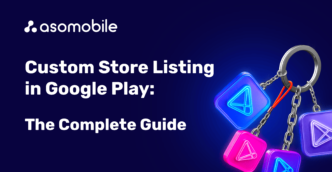ASO for countries of Asia: China, Korea, Japan.
If your application suddenly seems to have nowhere else to develop and grow, it's time to think about ASO optimization for countries of Asia. ASO optimization for countries of Asia. A little about the region itself, according to forecasts, by 2030, the share of smartphones per capita will exceed 90% (we suspect that smartphones for babies will appear by that time).
When we talk about the Asian market, the emergence (thanks to the market itself) of such a thing as a super application is also worth mentioning. This term is applied to apps that combine several different functions in one interface. We will talk about social applications, applications for messaging, shopping, banking, etc. - all together.
In this context, considering the diversity of the Asian market, it's crucial to delve into ASO local search strategies tailored for each specific country. For instance, ASO Hong Kong may require different optimization approaches compared to Japan ASO. Each market has its unique user behavior, cultural nuances, and popular app trends, necessitating a localized approach in app store optimization for China and other Asian regions.
Examples of super apps are:
- WeChat (China, launched in 2011), the application combines shopping, services, transportation, tourism, and finance. WeChat has over 1.3 billion active users and is the most popular app in the country.
- LINE (Japan, created in 2011), is a cross-platform app that is the dominant messenger in the market of Japan, Thailand, and Indonesia. The number of active users is 178 million.
- Also worth mentioning are Paytm, Grab, Goto, and Zalo in India, Singapore, Indonesia, and Vietnam.
The Asian region is large and diverse, but we will focus on its part and see which countries we will talk about:
- China
- Hong Kong
- Japan
- South Korea
China and the mobile app market
In 2022, the number of smartphone users exceeded 1.04 billion. According to forecasts, the number of users will increase and reach 1.18 billion. Taking into account the total number of users in the world (about 6.6 billion), China occupies approximately 15% of the total number of users.
The number of apps available to download in China is 2.3 million as of mid-2022.
Optimizing your app for the unique preferences and trends in the Chinese market is essential for success, emphasizing the significance of ASO for China.
The most popular category is short videos.
In addition to chatting and instant messaging apps, Chinese mobile users spend significant time on video entertainment. As of the last quarter of 2022, short video apps accounted for about 38 percent of Chinese users' daily app usage time.
The most popular apps for 2022 are WeChat, Alipay, and QQ.
In 2022, Chinese users accounted for about 35% of global consumer spending on mobile apps. Suffice to say, China's app economy is booming.
Hong Kong and its mobile market
We will talk about it separately from China since its mobile market indicators are worth mentioning:
- $1.28 billion, that's how much Hong Kong users spend on mobile apps.
- The share of Apple and Samsung is 76% percent, of which Apple is in the lead.
- The percentage of smartphone owners in the population is about 80%.
Hong Kong is one of the largest mobile app markets in the world. Behind more populous Brazil and Thailand, this small peninsula ranked 16th in consumer spending in 2021.
Hong Kong has one of the highest smartphone penetration rates in Asia. Nearly 90% of Hong Kong residents over the age of 10 own a smartphone, roughly equivalent to the seven million people who own smartphones.
In the app categories, everything is more or less homogeneous - 80 percent of users use instant messengers, and use them daily. Social media apps came in second, while gaming apps came in third.
TikTok's most popular non-gaming app with over 150K monthly installs (March 2023 data). In terms of mobile gaming, in January 2023, the casual game Goose Goose Duck, published by Gaggle Studios, became the top free gaming app in Hong Kong with over 86,003 downloads, and KartRider: Drift takes the second place with approximately 56,500 installs.
The share of users who use shopping applications every day is more than 20%.
South Korean mobile app market
The birthplace of one of the most popular smartphones in the world cannot but be of interest to mobile apps. By the way, the market share of Samsung smartphones in South Korea is 63.2%.
According to Statista, Korea is the 4th largest mobile app market in the world. But the complexity of this market seems to be that local applications are pushing even the world's giants. To see that, you can look at the popularity of search engines in 2022 (and we will not see Google in the first place):
- Naver
- Daum
But the market is still interested in expanding the geography of our applications, and now you will understand why:
- The total revenue on the app market by 2022 was $14.8 billion, and the forecast for 2027 is $22.37 billion.
- Revenue from in-app purchases by 2022 at the level of 11.22 billion dollars, advertising revenue - 3.52 billion.
- Number of downloads 1,796 million by the end of 2022.
And if your head is spinning from the opening prospects, then read on.
Smartphone users represent over 97% of the population. The average time spent on a smartphone is 5 hours a day.
Speaking about the South Korean market, it would be simply criminal to keep silent about mobile games. After all, the second thing that comes to mind after Samsung is eSports, but believe me, mobile games also do not take the wooden spoon; according to Statista, 84% of gamers play mobile games.
Mobile games across all platforms were downloaded over a billion times in South Korea last year, according to Apptopia research.
Japan and mobile games and applications
Japan is another source of growth and geographic expansion for your app. Despite its small size, this country boasts considerable influence on the global mobile market. Let's take a look at the numbers:
- The number of smartphone users is 101.7 million in 2022 (the forecast for 2027 is more than 115 million users).
- The presence of the LINE super app, which comes from Japan.
- The most profitable app for 2022 is Piccoma, followed by mobile games.
When it comes to smartphones, iOS rules the roost. In 2022, Apple's smartphone market share in Japan was approximately 66 percent.
According to research, user behavior shows a preference for installing free applications, and the main income of developers comes from in-app purchases. The most popular categories are instant messengers and social networks.
The mobile games market is developing and does not lose its popularity, because a significant part of users play mobile games every day.
In the realm of mobile app business, understanding the intricacies of Japanese ASO (Japan ASO) becomes pivotal. Adapting to the preferences of Japanese users, especially in the realms of mobile gaming and social apps, is crucial for successful penetration and sustained growth in the Japanese market.
Specifics of ASO optimization for the Asian market
It is quite difficult to single out the distinctive features of the so-called Asian region. All countries have striking differences in user behavior, government regulation, and cultural characteristics. If you have carefully read the statistics above, then you will agree with us that the unification of the requirements for app optimization will most likely lead to not the best result. Therefore, we will try to highlight the features of each country, which can then be useful in the work of an ASO specialist if you plan to expand and attract users in these regions.
ASO for the Chinese market
It should be noted right away that the Chinese app market is vast and diverse, and the app stores themselves also differ in variability. For more details, you can read our articles:
- Alternative stores and app market in China
- ASO app optimization for Huawei AppGallery
Unlike Google Play, the App Store has no problems with a presence in China, while Google services are being blocked and persecuted in every possible way. But despite this, Android is leading the Chinese market thanks to alternative markets. This is both encouraging and alarming; let's see why. The rules of the game will change depending on the app store, so the checklists we are used to for optimizing iOS and Android can only serve us half. Understanding the nuances and intricacies of each Chinese app store is crucial for effective ASO for China.
Let's pay attention to iOS since user behavior in Chinese realities does not differ from global trends, and therefore Apple users spend more than their counterparts. This shows us a great opportunity because ASO for iOS applications is a clear and manageable process for every ASO specialist. To optimize for other stores for Android-based apps, you will have to study the specifics of each (in the case of Huawei, we have already done this for you).
Well, but at least the App Store can and should be mastered, you might say, and you will be absolutely right, if not for one thing - the cultural and linguistic difference.
Chinese app optimization must start with the fact that you have a reliable translator and preferably a native one with an understanding of the specifics of the region. As in principle, for any country, the presence of “their person” who understands the features and cultural differences will be a plus. But China, in this case, should be put in the first place - the Chinese language is too complex, specific, and has a lot of shades (we are definitely not talking about using Google translator here). The accuracy of definitions and the correct arrangement of hieroglyphs are all shades of successful optimization.
App metadata for China
The app's name - to translate or not- is the question. The answer is - everything is very individual. If you look at the search results, many popular games and apps translate their brand names; someone mixes the brand and other keywords with hieroglyphs or completely translates the name. For example, despite its Chinese origin, QQ, a popular messenger, has part of the name in Latin letters. It doesn’t matter if you leave the title in the original or translate it; the main thing is to make sure that there is no double meaning or incorrect interpretation, and that the translation is generally consistent with reality. Perhaps choosing a brand new name will help your app find its way to the hearts of Chinese users. An alternative may be to indicate the game's original name or application in brackets since the conciseness of the hieroglyphs allows this, and you will meet 30 legal characters.
If you use the Similarweb resource, you can see both fully localized titles, mixed and original in the Top most popular applications.
The rules for the keywords that you will use in the title do not change depending on the country of optimization - all keywords must be relevant, frequency, and more; for iOS apps, we always take into account the Search Ads indicator (after all, it is for China geo).
Subtitle: completely echoes what was written for the title. We check the translation for adequacy, use relevant keywords and be careful when combining hieroglyphs, as some combinations may be ambiguous. And remember, you don't need to add indents or spaces between characters.
Description: if we are talking about the field of iOS apps, you can make no effort. But when it comes to user interaction, we recommend making the description concise, with clearly defined functions and benefits for users. Particular attention should be paid to social benefits - the peculiarity of cultural perception is extremely sensitive in matters of status and social norms.
Visual elements:
This is where you need to be extremely careful since this is the way to your users. We have already drawn your attention to the fact that search results in the Chinese market differ from European and Western trends. Therefore, it is worth paying attention to local features and trends.
Icon design features:
- use of the brand logo in the icon (a feature of the graphic style of the language allows you to hide the name in the logo).
- game characters have a more human nature of the display, less cartoony closer to a person.
- a strong influence of the color scheme, since the religious and cultural aspect of this country has a strong influence on perception. Red is the color of prosperity and wealth, colors that represent natural elements, etc.
Screenshots also have their own characteristics - for example, we compared the screenshots of the WeChat super app for the Chinese and US markets, and the difference is more than obvious.
We’ve already talked enough about the importance of cultural features, but it’s still worth mentioning some delicate points in visual design. Any elements that are interpreted as violence, gambling, or alcohol, may cause your app to be banned. Use bright and contrasting elements, perhaps for a European look, it will seem that the visual design is slightly overflowing with information, colors, and pictures, but remember - you are the invited guest here, your task is to please users, and they will not remain indifferent.
ASO for the Korean market
Let's go back to facts and statistics. Samsung's dominance in the Korean market will certainly interest us in terms of ASO optimization, which can traditionally be done here for two stores - Google Play and the App Store. But the attentive reader of our article about alternative app markets should also remember the Galaxy Store - the branded app store for all Samsung smartphones.
So platforms for optimization:
- App Store
- Google Play
- Galaxy Store
Since we consider the Korean market after the Chinese one, you should immediately draw your attention to the following facts - despite the fact that Korean is also a hieroglyphic language, the rules of Chinese do not apply here, but there are dialects here (the Seoul dialect is considered the state dialect and it is worth it use for localization). And yet, the characters in Korean are syllables, not words! We are again facing a new culture, user behavior, and preferences. Unlike China, South Korea actively uses a huge amount of English words, which will help us optimize the application for this market. Although the translator's false friends are waiting for us in this field - check the meaning of English words in Korean, as the meaning can sometimes be incomplete or opposite.
App metadata for South Korea
Given the previous information, the collection of the semantic core will take place in two languages - English and Korean, do not be surprised if the first one is in the majority. Korean users know English well and often enter search queries in it.
Title and a short description (subtitle): ASO optimization rules have not been canceled, and relevance and traffic will be the main factors in the use of words. Plus, the importance of correct translation and interpretation is to have someone check the word order in sentences, cases, and numerals (Korean has as many details as any other language).
Description: the text will be used more as an indexing factor than a way to convince the user of the uniqueness of your application (most likely, it will simply not be opened).
For textual metadata, it is fair to say that hieroglyphs meaning a syllable, not a letter, save space significantly. Spaces are already placed between words, do not forget about it, but there may be options here too - saving time, users often combine short words, which then turn into search phrases without spaces.
Visual elements:
And here, the spirit of minimalism does not rule the roost. Colorful, sometimes cluttered visual elements such as character icons, complex graphics and anime style all add up to an eye-catching look for your app page.
If your visual optimization contains photos of people, make sure they have a Korean appearance - this is a very important factor for users.
Color solutions are also important (as in any culture that has ancient and well-preserved traditions). In Korean culture, the colors red and black will have a negative connotation, while yellow and green will be the other way around.
ASO for Japan
Japanese ASO emphasizes the need for culturally tailored strategies. iOS is in the lead here, but don't forget about Google Play. Users in the Japanese market are known for their generosity, with Japan leading the way in per capita spending on mobile apps. But at the same time, users are more prone to free apps. How come? Yes, everything is quite simple - in-app purchases dominate here. Be sure to take this fact into account when planning your monetization. But let's talk about everything in order.
Features of the Japanese language - no spaces, several forms of writing, very strict word order, and no future tense. The difference in the forms of writing suggests that hieroglyphs can mean a syllable or a sound, and in another form of writing it will be a concept, an idea.
Metadata for Japanese localization
Language features will greatly affect text optimization. At the time of collecting the semantics, you already need to enlist linguistic support, because some keywords will have a different traffic rate depending on the form of the letter that is used (it always sounds like practical advice - check both forms). For effective app visibility, delve into the intricacies of Japanese language nuances with Japanese ASO.
Another feature is time - the chronology of Japanese perception is tied to the eras of the reign of the imperial dynasties, which is very far from the European and Western styles.
Numerology entered the chat when ASO for Japan was mentioned. It is hard to imagine more emphasis on numbers - remember Hachiko. Avoid the numbers 4, 9, or 13 - they all carry a negative connotation for the Japanese user. If suddenly your metadata or visual elements contain numbers - be vigilant.
Visual elements:
The most important thing for Asian visual optimization is to forget about minimalism. All information in one place is the motto of the Japanese design style, carefully study the features of the niche, and examples of well-designed apps, and take an example.
Visual ASO Features for Japan:
- The concentration of text and images in the screenshots is amazing, but that is the way of Japanese visual optimization.
- Colors and shades are very important in Japanese culture, which must also be taken into account when decorating. Flowers even have a gendered coloration, such as red being feminine and blue being masculine.
- Seasonality, as part of Japanese culture, can and should be reflected in visual optimization - cherry blossoms, wisteria season, elements, and the natural cycle. Seasonal optimization is one of the keys to the heart of the Japanese user.
- Icons and text. This again confirms the differences in design approaches; you can often see text on icons in Japanese search results.
- Appearance. Japanese appearance is a must because we offer a product or game on this market.
- Comic mode. Speech bubbles, bright emotions, appeal to users, cute characters in anime style. All this corresponds to the expectations and tastes of users.
ASO optimization tools
In addition to cultural understanding and the help of translators, you need to use a set of tools that will allow you to collect a semantic core, develop metadata and evaluate the results. On the ASOMobile platform, you can collect a semantic core for geos of interest to us; plus, a built-in translator will allow you to make a draft version of the semantic core, which can be given to the translator for verification. For specialized strategies in different regions, consider using tools specifically designed for Japanese ASO and app store optimization for China.
App Keyword will help you check which keywords the app is indexed for, with what traffic indicator, and in what place in the search results. To localize a messenger for the Chinese market, you can take the WeChat super app as a basis and find the semantics:
* do not forget about the possibility of auto-translation
To generate metadata, we will use ASO Creator (for example, for localization for the Korean market).
And to search for niche trends and visual design ideas, you should use the Visual Comparison tool.
Let's summarize
The Asian market, or rather that part of it that we examined in our research is an excellent prospect for the growth and development of your app. Yes, this is a different market, requiring a very rigorous approach and taking into account many details. We cannot call this review a complete guide to ASO optimization for China, Korean, and Japanese markets, since each country separately is a topic for in-depth research. But we really hope that we were able to interest you with exciting prospects and outlined those factors and features that you need to pay special attention to.
Arigato, Se se, Kamsamnida!
 Українська
Українська  Русский
Русский  Español
Español 






